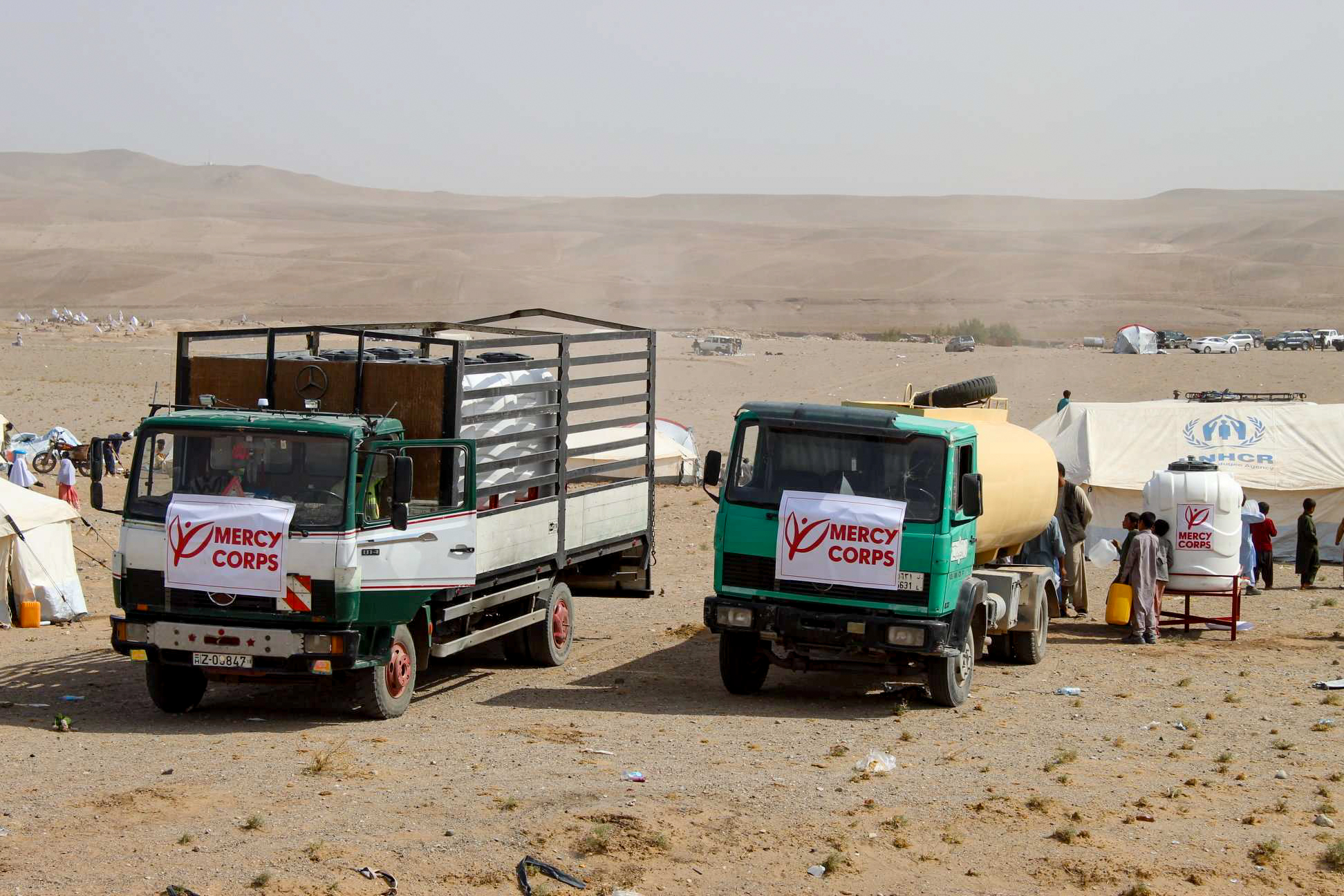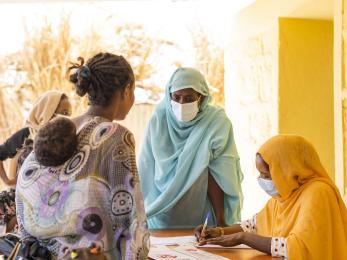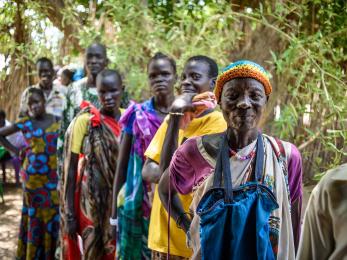The facts: Afghanistan

Decades of ongoing conflict, political instability, drought and economic chaos have left Afghanistan as one of the world’s poorest and most unstable nations.
Afghanistan is also the world’s second-largest source of refugees, with 2.5 million people displaced outside the country — and likely more who are not registered.
Many of those still living in Afghanistan depend on agriculture and natural resources for their livelihoods, leaving tens of millions of people vulnerable to the increasing threat of climate change.
But Afghanistan has the potential to recover and become a stronger state, built on the foundation of a flourishing economy. As the country works to emerge from decades of fragility, we’re helping them build back stronger.
Read on to learn more about what’s happening in Afghanistan and find out how you can help.
Where is Afghanistan located?
Afghanistan is a landlocked country in South-Central Asia — not the Middle East, as commonly assumed. It’s about the size of Texas.
What is happening in Afghanistan in 2019?
Afghanistan needs sustainable economic growth to help people rebuild their lives after years of struggle. There is some promising progress: exports have increased from $596 million in 2016 to an estimated $1 billion in 2018. Its primary exports are fruits and nuts.
About half of the population is dependent on agricultural income, and agriculture activities account for 25 percent of GDP. As climate change worsens, so does the reliability of those livelihoods.
Almost one-quarter of the population is unemployed. Each year, 400,000 Afghan youth are in need of a job. The jobs that are available often don’t pay well enough to pull people out of poverty.
Afghanistan is rich in untapped mineral resources that might be worth up to $1 trillion.
Natural disasters
Decades of conflict along with limited environmental investment make Afghanistan increasingly vulnerable to natural disasters.
Since the beginning of 2019, more than 260,000 people were affected by natural disasters throughout Afghanistan. Thirty provinces — out of 34 total — experienced some kind of natural disaster, ranging from earthquakes and flooding to drought, landslides and avalanches.
Drought, in particular, has affected more than two-thirds of Afghanistan, leaving people who rely on agriculture in desperate situations where they need both food and new ways of earning income.
Elections in Afghanistan
The next presidential election in Afghanistan will be held on Sept. 28, 2019. It has already been rescheduled twice. There are security concerns about the current voting system.

How have people in vulnerable communities been affected, particularly women and children?
About 75 percent of women live in rural areas, where conflict interrupts access to critical services. Infant mortality rates are among the highest in the world at 70 per 1,000 live births and an estimated 10 million people have limited or no access to essential health services.
With continued insecurity expected this year, 1.9 million malnourished children and nursing mothers will require humanitarian assistance.
Displacement is only exacerbating these serious issues. On average, 1,100 people each day — two thirds of them women and children — were forcibly displaced by violence in 2017.
And these vulnerable groups continue to grow. Approximately 64 percent of the population is under the age of 25. They will need their basic needs met as they develop, and economic opportunities when they reach adulthood.
Their educations are also at risk. Many public buildings, including some 4,500 schools, will be used in the upcoming elections, making them potential targets for attack and causing interruptions to students’ education. Already, as many as 3.5 million children are out of school — 75 percent of them girls.
How does Afghanistan aid get to people in need?
We provide aid directly to Afghans in need. Since 1986, we have helped over 2.5 million Afghans improve their lives through agricultural support, vocational training, natural resource management, access to affordable renewable energy and economic development. We have a market systems approach to all we do, which helps grow the economy locally and sustainably.
How is Mercy Corps helping?
Mercy Corps has worked in Afghanistan for 33 years, with a vision to improve Afghans’ quality of life by strengthening their sustainable, equitable, and legitimate livelihoods. Last year our work benefitted more than 441,000 people. Six in ten of the people we worked with were children and young people under 25 years old.
We achieve this success through implementing programs in six strategic areas:
Agribusiness development
We know that when the agricultural economy becomes more productive and profitable, then more farming households engage proactively in markets and increase their income.
Mercy Corps’ agribusiness programming has reached 56,051 beneficiaries over the past 33 years. In one UN-funded program in southern Afghanistan, from 2015 to 2019, we directly trained and supported more than 7,380 Afghan farmers. They farm a total of nearly 3,000 acres, planting and producing opium alternative crops such as grape, almond, pistachio, saffron, and vegetables.
Job skills for young people
We help young people improve their employability, and address the shortage of skilled workers, by providing vocational training in jobs that are in demand.
In 2010, we introduced center-based vocational training and links to employment and have since increased the marketable skills of more than 37,204 Afghans, with over 40 percent female participation. Six months after graduation, 63 percent of trainees remained employed.
Trainees completed our market-oriented courses in more than 30 technical trades, including tailoring, embroidery, mobile phone repair, solar installation, and other employment or self-employment ventures. We strategically connect graduates with relevant market employers and associates, who link them with job opportunities. We also help graduates start their own businesses. Currently, our vocational training model is being replicated in 13 of Afghanistan’s 34 provinces.
Natural resources management and WASH
Managing natural resources well creates income opportunities for households through agriculture and livestock. This management also protects people from potential sources of conflict in the future.
That’s why we have strengthened the institutional capability of 40 water user associations (WUA) in northern Afghanistan since 2007. WUAs are able to rehabilitate existing but dysfunctional or inefficient irrigation systems, manage water equitably through plans and irrigation service fees, and enable efficient use of limited water resources to improve agricultural productivity.
Our Afghanistan team is implementing a WASH program, which provides humanitarian assistance to an estimated 58,500 long-term IDPs and returnees in six IDP camps and settlements in Herat by meeting critical water and sanitation needs and improving hygiene practices.
Affordable renewable energy
Easily accessible and affordable clean electricity means more prosperous and productive homes, businesses and communities. It also reduces harmful greenhouse emissions.
Thanks to Mercy Corps, the Bost University Hospital in Helmand is using a solar-powered system for 90 percent of its energy needs, effectively saving an estimated $4,700 in expenses on diesel fuel every month. During 2016, 1,800 students (including 385 women) and approximately 12,000 patients benefited from reliable operation of medical equipment, running tests and medical procedures in a timely manner.
The hospital repaid Mercy Corps for the lease of the system in December 2018 — these funds will finance the installation of systems for other businesses seeking improved electricity supply.
In addition, Mercy Corps installed an additional 12 off-grid systems for households and businesses in Kabul Province, including a system at a cold storage facility within a fruit market. That customer's electricity expenses have dropped from $1,000 per month to $480 through the leasing of the solar-powered system, and in three years, the customer will own the system outright.
We have also developed a solar-powered system training and are providing vocational training centers, which are delivering basic-to-intermediate level skills around solar power.
Humanitarian readiness
Our humanitarian assistance looks forward, toward long-term sustainability. The services we provide to returnees and IDPs help them move toward sustained, meaningful resettlement and attain a higher level of resilience.
One way we do that is by establishing local markets where farmers can grow their incomes and their local economies. We are working to generate over 3,000 long term jobs and further boost up the added value of local products by reducing the existent security risks during transportation and increasing investment in cold storage, packing houses and processing facilities.
Effective monitoring and learning
We aim to monitor and evaluate our programs carefully, making sure our assessments are independent, customer-focused and data-driven. The programs we implement are based on years of learning from the people we’re helping, as well as rigorous analysis.
We are strongly committed to Afghanistan’s people, borne out by our three decades of work helping them overcome adversity and build better, stronger lives.
You can join us.


